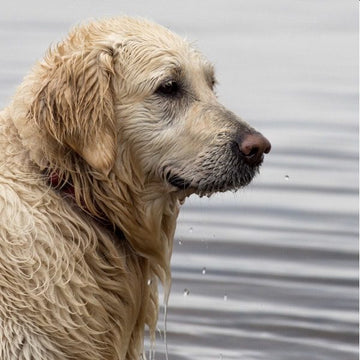Many dogs love a cold dip in Danish lakes or beaches, especially in the summer!
A nice swim can be both cooling and stimulating, as well as being a good exercise for the dog, but there are some precautions that may be important to take before you let your four-legged friend loose in the water.
That's why we've put together some advice so that both you and your dog are safe on the swim.
Where can my dog bathe?
Dogs must be kept on a leash from April 1st to September 30th on public beaches. In addition, you should pay attention to the beach flags and other signage - a blue flag means that you are not allowed to take your dog to the beach unless it is a guide dog.
Luckily, for us dog owners, there are some fantastic dog beaches where your dog can freely frolic in the sand and swim around in the water - of course, provided that you have control over your dog when it is not on a leash. We have collected some of our personal favorites on Zealand here:
- Amager dog beach (free-range area north of Amager beach)
- Hornbæk dog beach (Hornbæk)
- Smidstrup dog beach (Gilleleje)
- Høve dog beach (Asnæs)
Tips for your beach visit
Remember clean drinking water
The beach is a playground for most dogs and combined with high temperatures, it can make our dogs thirsty. This may mean that your dog will try to quench his thirst by drinking salt water. Ingesting salt water is harmless in small amounts, but there is a risk of salt poisoning if it is consumed in large doses.
Make sure your dog has access to clean drinking water and bring toys that can float so the dog doesn't have to go down to the bottom of the sea to retrieve his stick - See our portable water bowls here.
Give your dog a bath after visiting the stand
Salt water can also cause skin irritation - in addition, some beaches and lakes may contain toxic algae that can make your dog sick. Make sure to give your dog a bath to rinse the salt water off his coat and use a dog shampoo to make sure his coat is completely clean.
If your dog becomes lethargic or starts vomiting after a trip in the water, you should contact your veterinarian and give it an extra bath to remove potential algae from its fur.
Swimming assistance
The dog life jacket is not only helpful if you are going sailing with your dog, it is also super ideal when your dog is going swimming, especially if it is the dog's first time. Unforeseen waves and undercurrents can be a risk when you let your dog swim freely, and therefore a life jacket can be good - both because it provides buoyancy if your dog gets tired, but also because it is easy to spot in the water and with its handle makes it easy for you to control the dog in the water.
Be aware of Swimtail:
If your dog's tail hangs down a lot, doesn't move, and is sore, it could be a symptom of swimmer's tail. Swimmer's tail is a sterile inflammatory condition in dogs' tail muscles that generally only occurs after the dog has swum or bathed a lot - usually a combination of overexertion and cold. It can be painful for the dog, so it's a good idea to get it diagnosed by your vet as soon as possible.
You can try to prevent swimmer's tail by limiting your dog's bathing intervals, and making sure to dry your dog well after bathing, so that the dog and its tail are dry and warm - you can invest in a bathrobe that helps dry and keep your dog warm, see our selection here





